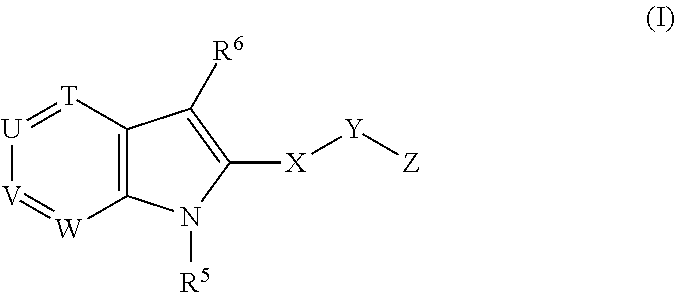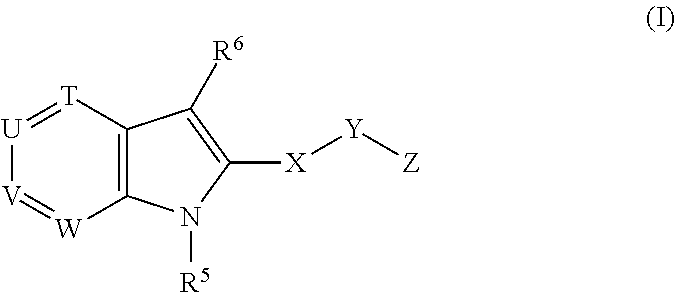Novel indole derivatives useful as Anti-diabetic agents
a technology of indole and derivatives, applied in the field of new indole derivatives useful as anti-diabetic agents, can solve the problems of insufficient insulin-mediated activation of uptake, oxidation and storage of glucose in muscle, inadequate insulin-mediated repression of lipolysis in adipose tissue, and inability to achieve the effect of reducing the risk of diabetes in patients
- Summary
- Abstract
- Description
- Claims
- Application Information
AI Technical Summary
Benefits of technology
Problems solved by technology
Method used
Image
Examples
example 1
[1010]
5-((6-chloro-5-(4-(pyrrolidin-1-yl)phenyl)-1H-indol-2-yl)methyl)-2-methylbenzoic acid
Step A: methyl 5-((6-chloro-5-(4-(pyrrolidin-1-yl)phenyl)-1H-indol-2-yl)methyl)-2-methylbenzoate
[1011]Methyl 5-((5-bromo-6-chloro-1H-indol-2-yl)methyl)-2-methylbenzoate (95 mg, 0.242 mmol), 1-[4-(4,4,5,5-tetramethyl-1,3,2-dioxaborolan-2-yl)phenyl]pyrrolidine (72.7 mg, 0.266 mmol) and Pd(Ph3P)4 (7.0 mg, 6.05 μmol) were mixed in a microwave vial, which was evacuated and charged with nitrogen. Then DME (1.9 mL) and 2N Na2CO3 (272 μl, 0.544 mmol) were added. The reaction was stirred at 80° C. in an oil bath for 3.5 hours. Then additional Pd(PPh3)4 (7 mg) was added and the reaction was stirred overnight. The reaction mixture was then partitioned between ethyl acetate and water. The aqueous layer was separated and extracted again with ethyl acetate. The organic layers were combined, and washed with brine, dried over sodium sulfate, filtered and evaporated. The crude product was purified on a Biotage...
example 5
[1013]
5-((6-chloro-5-(3-fluoro-4-(pyrrolidin-1-yl)phenyl)-1H-indol-2-yl)methyl)-2-methylbenzoic acid
[1014]Methyl 5-((6-chloro-5-(4-(pyrrolidin-1-yl)phenyl)-1H-indol-2-yl)methyl)-2-methylbenzoate (48 mg, 0.105 mmol) was dissolved in CH2Cl2 (3000 μl). Then Selectfluor™ (38.3 mg, 0.108 mmol) was added and the reaction was stirred at room temperature for 4 days. More CH2Cl2 was added to the reaction as needed to keep the reaction volume at about 3 mL. Then the reaction was partitioned between water and CH2Cl2, and the organic layer was separated, washed with water (2×) and brine. The organic layer was dried over sodium sulfate, filtered and evaporated. The crude product was dissolved in THF (1.5 mL) and MeOH (0.5 mL). Then NaOH (0.105 mL, 2.5N) was added, and the mixture was stirred overnight at room temperature. The reaction was then heated to 40° C. for another 24 hours, and quenched by the addition of 1N HCl (0.263 mL). The reaction mixture was partitioned between water and ethyl ace...
example 6
[1015]
5-((6-chloro-5-(4-(1-(hydroxymethyl)cyclopropyl)phenyl)-1H-indol-2-yl)methyl)-2-methylbenzoic acid
Step A: 5-((5-bromo-6-chloro-1H-indol-2-yl)methyl)-2-methylbenzoic acid
[1016]Methyl 5-((5-bromo-6-chloro-1H-indol-2-yl)methyl)-2-methylbenzoate (39.3 mg, 0.1 mmol, Intermediate 3) was dissolved in methanol (450 μl) and THF (450 μl). Then 5N NaOH (100 μl, 0.500 mmol) was added, followed by water (100 μl). The reaction was heated to 40° C. and stirred for 2 hours. Once the reaction was complete it was cooled to room temperature and the reaction was neutralized with the addition of 1N HCl (0.5 mL). Then ethyl acetate and water were added, and the resulting layers were separated. The organic layer was dried over sodium sulfate, filtered and evaporated. The crude product was used in the next step without further purification. LC-MS: calculated for C17H13BrClNO2 376.98 / 378.98, observed m / e: 378.4 / 380.4 (M+H)+ (Rt 1.22 / 2 min).
Step B: 5-((5-(4-(1-(acetoxymethyl)cyclopropyl)phenyl)-6-chlor...
PUM
| Property | Measurement | Unit |
|---|---|---|
| Pharmaceutically acceptable | aaaaa | aaaaa |
Abstract
Description
Claims
Application Information
 Login to View More
Login to View More - R&D
- Intellectual Property
- Life Sciences
- Materials
- Tech Scout
- Unparalleled Data Quality
- Higher Quality Content
- 60% Fewer Hallucinations
Browse by: Latest US Patents, China's latest patents, Technical Efficacy Thesaurus, Application Domain, Technology Topic, Popular Technical Reports.
© 2025 PatSnap. All rights reserved.Legal|Privacy policy|Modern Slavery Act Transparency Statement|Sitemap|About US| Contact US: help@patsnap.com



